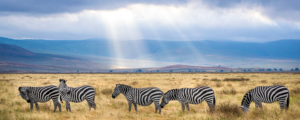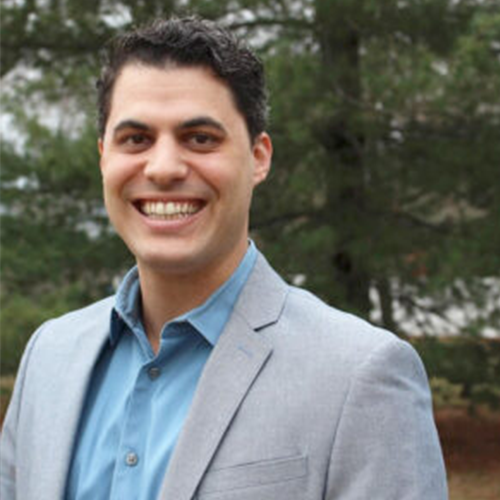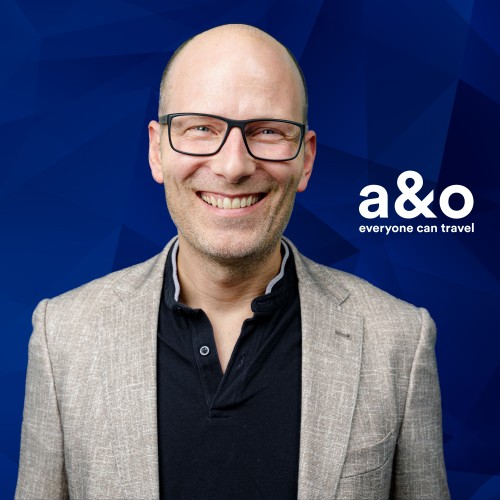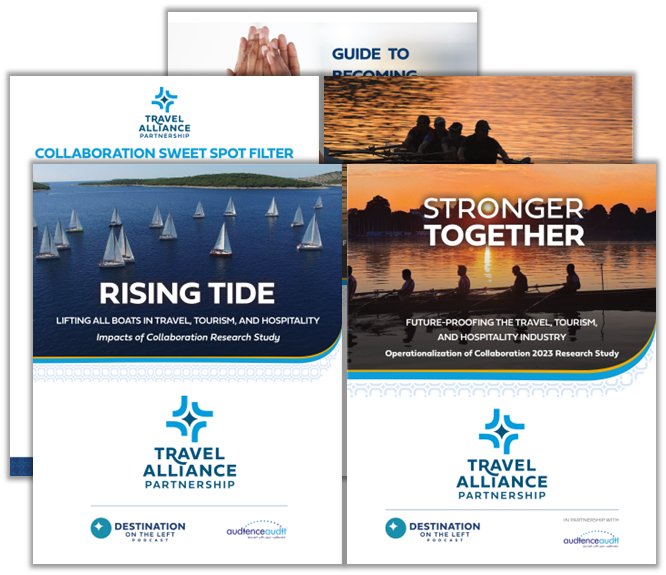The Invisible Burden of Tourism, with Tanner Knorr
Episode 176
Tanner Knorr manages EplerWood International’s new business, develops the newsletter, and continues to build a presence for the company via public relations, social media, and events. Tanner holds a Bachelor’s in Archaeology and a Master’s in Administrative Studies, concentrating in Economic Development and Tourism Management from Boston University. He was also a Teaching Assistant at Harvard Extension. He owns a business called Off Season Adventures that strives for sustainable tourism practices in Tanzania, Ethiopia, Tunisia, Uganda, Rwanda, and Nepal, and is the President of Second Look Worldwide, a 501(c)(3) organization that sponsors infrastructure improvements around tourism destinations in the developing world. In this episode of Destination on the Left, Tanner Knorr, the Program Manager at EplerWood International and the Founder of Off Season Adventures, joins us to talk about Destinations at Risk: The Invisible Burden of Tourism. He discusses the impact of crisis scenarios and overtourism on destinations, and explains what we can do to manage unaccounted for destination costs to provide local infrastructure and protection of eco and sociocultural systems for tourism and local people.
What You Will Learn in This Episode:
- How to access The Invisible Burden Report, a report that helps destinations uncover and account for hidden costs to protect and manage vital assets worldwide
- Why The Invisible Burden Report can help DMOs support responsible tourism growth
- The primary goal of The Invisible Burden Report and how it came about
- Who was involved in the collaborative effort it took for The Invisible Burden Report to materialize
- The individual subsectors of a destination that are affected by overtourism
- Phase two of the research report and what we can expect to see
- The key findings of last year’s research report
- The concept of holistic accounting and how it works
Collaboration in a Time of Crisis
Tanner Knorr is the Program Manager at EplerWood International and Owner and Founder of Off Season Adventures. He is a self-proclaimed sustainable tourism entrepreneur who is dedicated to making infrastructure improvements around tourism destinations in the developing world. Through our conversation, Tanner discusses the recently-released research study, Destinations at Risk: The Invisible Burden of Tourism. At a time when our industry is in turmoil due to the impacts of the global pandemic, there is an opportunity to open our minds to new ideas and possibilities. Download the research report and start understanding what we can do to support responsible tourism growth.The Invisible Burden
The Destinations at Risk: The Invisible Burden of Tourism report was put together by EplerWood International, the Cornell Center for Sustainable Global Enterprise and The Travel Foundation in the UK. The main goal of this report is to uncover the “invisible burden” of tourism which Tanner defines as the unaccounted for destination costs to provide local infrastructure and protection of eco and sociocultural systems for tourism and local people. It is difficult enough for destinations to find those pieces of the puzzle, so EplerWood International and its collaborators are stepping in to help them manage and finance more efficiently.Overtourism
When we talk about The Destinations at Risk: The Invisible Burden of Tourism report, there are a number of different subsectors of a destination that are affected. When tourism populations exceed the populations of the destination, we start to see destinations crack under the weight of it. It affects things like energy, greenhouse gas emissions, water, solid waste, sewage, and other natural and social capital. Tanner Knorr and his associates are working diligently to mitigate the risks of overtourism and manage the issues that have already arisen. Currently, they are working on phase two of The Invisible Burden where they will provide the necessary skills training to people on the ground.- Website:
- Destinations at Risk: The Invisible Burden of Tourism Report: https://www.thetravelfoundation.org.uk/invisible-burden/
- LinkedIn:
- Facebook: https://www.facebook.com/OffSeasonAdventures
- Twitter:
Nicole Mahoney: 00:18 Hello listeners, this is Nicole Mahoney, host of destination on the left and welcome to this week’s episode with another interesting guest, Tanner nor program manager, Apple or wood international and the self-proclaimed sustainable tourism entrepreneur. During our conversation, Tanner and I discussed the recently released research study destinations at risk, the invisible burden of tourism. I found this conversation relevant and informative, especially at a time when our industry is in turmoil due to the impacts of the recent pandemic. As we are all aware, our society will be forever changed by this experience and we have opportunities to open our minds to new ideas and possibilities. After you listened to this episode, please go to the show notes for this episode and download the full resource research report. It is a wonderful resource for communities to begin thinking about the true cost of tourism and how they can support responsible tourism growth. Now. Well, let’s get into the interview. Tanner, thank you so much for joining us on destination on the left. I am so excited to learn from you today and I’m really excited about this subject, uh, because it’s one that I know my listeners and our audience have been talking about and wondering about. And I think this research is going to be so important to everyone. But before we get started with the questions, could you tell us a little bit about yourself and your story? I find it adds so much more to the contract
Tanner Knorr: 01:59 of course. And Nicole, thank you so much for having me on. Really happy to be here and speak with you about the invisible burden. Um, my name’s Tanner Knorr. I’m the program manager for [inaudible] international. I’m also the owner and founder of [inaudible], my private company tour operator called off season adventures and the president of a nonprofit called second look worldwide. Mmm. My, my background, uh, I started, uh, as a bachelor in archeology that brought me to Menorca where we were on a dig. And, uh, in addition to learning the archeological skills, we also learned about cultural heritage management, which then got me interested in tourism. I went back to school for a master’s in economic development and tourism management. Um, from there, uh, I started working with Megan [inaudible] at [inaudible] international, um, uh, first as more of a communications, um, but then now two program managers. So I helped with all projects that she has going at this time, um, to make sure that they’re operating smoothly and being able to be communicated effectively to the public via our social channel and newsletter.
Nicole Mahoney: 03:19 That’s, um, that’s really awesome. You know, what’s really cool is that you have this, um, research background, uh, and you’re about to talk to us about this research paper, but that you’re also actively involved in the travel and tourism industry, you know, with your tour company. And I’m curious if you could tell us a little bit about the second look worldwide. I’m curious if that is also related to this industry.
Tanner Knorr: 03:46 It is, and I enjoy being a part of different categories of the tourism industry. I think that it gives me a wider look on Mmm. On the, the industry itself. Um, so yes, so off-season adventures is a tour operator. We go to five different destinations or in Africa and one in Asia. Um, I started that a few years ago and then we, in addition, uh, in the end of 2018 we’ve launched a nonprofit where 5% of the off season adventures funds goes into the nonprofit to sponsor infrastructure improvements around the destinations. Mmm. We, we enjoy seeing those two organizations work together, but then now that we have fiber one C three status, we’re able to also take additional funds to be able to sponsor our projects on the ground. So yes, to your question, they are all related in some way to the tourism industry.
Nicole Mahoney: 04:48 Yeah. And that, that’s fantastic. And, um, and, and I love that you started that nonprofit and I think our listeners will understand a little bit more about how that really does relate to this, this research as well. So, um, Tanner, can we start with you actually giving our listeners kind of a overview of this research, the invisible burden of tourism. How did this study come about and what was the primary goal of it?
Tanner Knorr: 05:15 Sure. So the destinations at risk, the invisible burden of tourism report was put together through a collaboration of [inaudible] international, the Cornell center for sustainable global enterprise and the travel foundation in the UK. Um, the, the main goal of the report was to uncover the invisible burden of tourism, which we’re defining as the unaccounted for destination costs to provide local infrastructure and protection of [inaudible] eco and socio-cultural systems for tourism and local people. So not only discovering, um, those pieces of the puzzle that, um, as a whole art pretty missing on the destination level, but then also moving past that and saying how to manage it and then how to finance it. Um, this report came out last year and phase two, which we’re really excited to announce, um, will be coming out soon. Uh, and this will discuss the more technical skills of how to manage and monitor tourism development on the ground for deemos. And other organizations involved.
Nicole Mahoney: 06:23 Yeah. I’m really glad to hear that there’s a second phase that you’re working on because I, I know after reviewing the report myself, those were some of the questions that I had. Okay. What’s, you know, what’s next? Who is actually gonna implement this and how are we going to do it? But before we talk a little bit more about that, Mmm [inaudible] I’m curious if you could elaborate a little bit on, um, you know, over tourism. That is a word that’s been used quite a bit lately. As a matter of fact, I think even the [inaudible] in the opening of the research [inaudible] it said it was one of the top words, was it in 2018? Uh, and I know this is something that’s been on the minds of, you know, a lot of our listeners and, and wondering what does that mean to them and what is it that they can be doing to help mitigate that. So he talked a little bit about kind of, you know, you talked about the financial Mmm burden or the unaccounted for costs. Can you go into a little bit more depth about what those areas, those cost areas are that the report looks at?
Tanner Knorr: 07:32 Absolutely. So the report discusses, um, individual sub sectors of the tourism industry that are affected when tourists come to a destination. Now we call it the invisible burden because many destinations don’t feel this as tourism has start. It’s starting to develop in those places. Uh, but as we see, um, especially in places like the Caribbean or in and I’m certain European cities where sometimes tourism at peak season can be even over the amount of population of the citizens. Um, we start to see that the destinations are beginning to crack under the weight of tourism. And these are through specific industry sectors like energy, greenhouse, gas emissions, water, solid waste, sewage and other, a natural and social capital on the ground. Um, we, we, we’ve tried to identify ways to be able to manage these, uh, in more broad terms, um, such as using smart destination planning, master planning, mapping, gas, geo design and holistic accounting. But we’re really excited that the second phase of the research is actually going to get into those specific skillsets. So, um, actually being able to train and teach people to use holistic accounting methods, data management, reporting systems, how to collaborate between local authorities and the private sector, and also the financial mechanisms that can actually fund, uh, these types of projects to better manage tourism growth and then see the value per tourist in a destination actually increased rather than decreased.
Nicole Mahoney: 09:19 Mmm. And, and so I’m curious, you mentioned, you know, in some cases, uh, some destinations you mentioned specifically the, the Caribbean and some of the European, uh, destinations, and I’m sure there are others, but, uh, where, where the visitor count actually exceeds the number of residents there. And then I’m curious if these impacts that you studied, do they also affect smaller destinations and maybe even destinations where the visitor count doesn’t necessarily Mmm. You know, go over the population count. And if you could speak a little bit about that too.
Tanner Knorr: 09:57 Absolutely. Um, I, I personally think that over tourism, sure. Mainly be seen as, uh, a way to look at carrying capacity. So it doesn’t necessarily depend on how many people you have at the destination itself, but it’s more the destination’s ability to handle the amount of people that are there. So if you’re seeing a great surge, um, uh, tourism coming into the destination, there’s doubtedly going to be, uh, enough infrastructure in place to be able to manage those individuals. So maybe that number is a hundred, maybe it’s a thousand, maybe it’s a million. Um, but at some point, the, the destination is kind of going to [inaudible] tip off balance. Um, and we need to create systems to be able to invest in the destination so that it doesn’t continue to fall apart.
Nicole Mahoney: 10:55 Okay. I think that’s really helpful. I think it gives us a much clearer kind of context for, um, you know, for what we’re talking about and how we’re, um, maybe defining right, what, what this means and really for me, trying to make it relatable to all destinations and not just, you know, to some of those who are obviously experiencing this imbalance now. And so I’m, I’m wondering if you can talk a little bit about some of the key, uh, findings, uh, in the, in the research report that was completed last year.
Tanner Knorr: 11:32 Absolutely. So identifying those specific, uh, subcategories within the industries. So, uh, again, like the energy, water waste, um, identifying those categories for each destination is going to be different. So in the report we give some strategies on how to find out what those, um, in addition to giving suggestions on, um, potentially the ways that this burden could be managed on the round. Mmm. And, and then of course financing it. Mmm. There RFQ strategies, um, that have been discussed within the report. But again, that’s why we’re really excited about the second phase because it gets more tactical and it gives, um, actual, it will give actual examples of [inaudible] to do things on the ground by the people that are responsible for managing tourism growth. And so we’re really excited for that report to come out. Mmm. Some things though to that we can talk about are some of the ideas of financing.
Tanner Knorr: 12:37 I think many destinations, they [inaudible] might look at this and say, Oh my gosh, it’s going to cost so much. How are we going to pay for this? And the first thing that a lot of people think about are the tourism taxes and fees that can be used as a strategy. Um, the industry, I think as a whole though, um, if you’re managing tourism growth, uh, perhaps mainly from the marketing side on a destination, you might see this as a negative because it adds a fee to each tourist when they’re coming to the destination. But what we’ve actually seen is that it can really help build the branding of the destination. So in places like New Zealand, uh, where they’ve added, uh, uh, uh, essentially like a visa fee, um, to go into investing in the natural world, uh, in New Zealand, that is actually built up their reputation because tourists see that such a beautiful landscape.
Tanner Knorr: 13:37 It’s very well maintained and they’re willing to pay more for it. Um, other strategies that have been considered are Mmm. Certain other mechanisms like, uh, conservation, finance impact investing, green bonds, maybe even some sort of a trust funds, uh, like is in place and beliefs, but doing that on a global scale. So some of the research that Megan’s working on right now with Cornell is I’m observing some of these financial impacts here, some of these techniques and how feasible they would be. And then of course, we believe that climate change is the number one risk to the tourism industry. Mmm. As a whole in the longterm. And linking tourism investment to climate change and investing in green infrastructure cannot only, uh, offset some of the impacts from climate change and lessen the amount of greenhouse gas emissions. But it can also then in the longterm, raise the value per tourists at the destination as it continues to grow. Mmm. Overall, um, the tourism industry, it has not declined in the past 50 years or so. Um, so although we might be in a slight lull right now, um, we believe that the next, okay, maybe you’re two or five years, 10 years overall will see that increase begin again and we’ll be dealing with a lot of the same issues. So now that we’re in this period of pause, um, I think, aye, I personally believe that it could be a really great time for governments as small businesses, um, and other entities involved in tourism management in each destination to come together and try and think through, um, how they’d like to develop tourism growth moving forward.
Nicole Mahoney: 15:37 Yeah, I think that’s a really good point. And, um, what I’m, as you’re talking is a first step might be just really to have the awareness right. And though
Tanner Knorr: 15:52 what I like about this research is it kind of gives you a way to
Nicole Mahoney: 15:57 look at and think about those, you know, invisible
Tanner Knorr: 16:00 costs, if you will, in terms of infrastructure. Where are we in terms of being able to,
Nicole Mahoney: 16:08 Mmm, manage,
Tanner Knorr: 16:10 uh, the capacity that we have, the capacity that we have with our visitors here. And then if we continue to watch a rise in visitation, as you’ve mentioned, which has been increasing year over year for many years now.
Nicole Mahoney: 16:24 Mmm.
Tanner Knorr: 16:24 Where is that
Nicole Mahoney: 16:26 breaking point or that tipping point
Tanner Knorr: 16:29 going to happen?
Nicole Mahoney: 16:30 Is that,
Tanner Knorr: 16:31 is that what you’re saying? Am I, yeah, it’s, it’s an interesting question and I think from destination to destination that, let’s say breaking point will always be at a slightly different point, but, but yes, that’s the first step is what we’re encouraging, especially with this report, is to have people read through it, have people read through it again, because there’s a lot of concepts that are very new to a lot of people that are managing tourism within destinations. Um, the, uh, as a whole, um, the deemos and other organizations are really, really good at managing, uh, the marketing side. But what we’re saying is that there needs to be a balance. You, you have all of this, this revenue coming in. Where’s the management on the other side, Howard? How are those, how does that funding, um, being translated to better management practices? When tourists, uh, begin to come to a destination and then begin to grow.
Nicole Mahoney: 17:36 Right? Exactly. And, and what I find very interesting is, um, I mean, we all know that tourism, um, really does help, uh, with quality of life in many places. You know, not only does it help with the economy, but it also helps support, uh, you know, parks and help support cultural institutions. And all of those things that make up a community, a great place to live are the same things that make it a great place to visit. Mmm. But I think you’re giving us a whole new kind of lens to look through in terms of thinking about what is it though?
Tanner Knorr: 18:13 How is it impacting
Nicole Mahoney: 18:15 the local Mmm.
Tanner Knorr: 18:18 Infrastructure,
Nicole Mahoney: 18:19 right? And these things,
Tanner Knorr: 18:21 energy, water, waste,
Nicole Mahoney: 18:24 you know, natural resources, et cetera, and making sure that we’re mindful of the entire ecosystem and not just the [inaudible], the, uh, the one piece of it,
Tanner Knorr: 18:34 right. And those, those resources that are on the ground that people are coming to see. Um, we call them the common pool resources. So they’re there essentially public things. So, whether that’s a beach or a museum or a monument, these are the things that people are coming to see when they go to a destination. And so often we’ve seen these assets, um, not being managed properly or with enough funding to [inaudible] properly maintained. And so they, they start to crumble when there’s so much visitation going through. Mmm. We, we think that there’s, that managing the invisible burden is not only for the benefit of tourism growth then the marketing side, but you’re right, it’s also for the local people and the local businesses that are also benefiting from Mmm. [inaudible]. Perhaps those higher paying tourists if the destination is managed in a better way.
Nicole Mahoney: 19:33 Yeah, absolutely. And I, I’m also curious, um, you talk a lot about, you know, master planning and I know a lot of communities, a lot of destinations already, um, do master planning or they have done master planning or it could be something that they’re planning that they, you know, it comes around every 10 years, 15 years, whatever it is. And I’m curious if you’re seeing or through your research, if you’ve seen, um, communities really start to include
Tanner Knorr: 20:03 this type of Mmm
Nicole Mahoney: 20:06 thought process into the master plan, or is it that you’re saying that hasn’t started yet
Tanner Knorr: 20:12 and with the release of this report, we’re hoping that that’s going to start bubbling up, right? More of the latter. Um, as a whole, no. Um, we haven’t seen this type of thinking being introduced to the longterm planning. However, we are seeing some destinations, uh, begin to do that. Um, Megan is working, um, with a few destinations, a handful of destinations around the world to help them plan out, um, tourism on a 10, 20 year plan. Um, and I think that being able to use things like master GIS, geo design, um, which are mapping systems, um, being able to visualize that, I think Ken, um, give a much better view point of the types of things that destinations are dealing with. And that visual means sometimes is, uh, even a better way to get things communicated across to policy makers as well.
Nicole Mahoney: 21:11 Absolutely. And so, um, one of the things that you’ve talked, we’ve talked a lot about is capacity and, and I know in, in the research you talk about destination management capacity and, um, really being, I think proactive, uh, in understanding all of this and one of those tactics or strategies [inaudible] destination management capacity is this idea of holistic accounting. And I know you talked about it a little bit earlier, but I’m wondering if you can kind of expand on that a little bit more. Um, for our listeners, because I’m [inaudible] I’m sure it’s probably a new concept to them. And you talk a little bit more about what you mean by holistic accounting and kind of
Tanner Knorr: 21:53 how that works. Absolutely. So we like to think of it a bit more like a business. So if your [inaudible] say you have a factory and you’re producing a good, um, you have the marketing to end the sales to be able to sell that product. But as your Mmm, product starts to be sold more and more rapidly, you might need some additional funds to be able to maintain the building or the manufacturing equipment or something else. Maybe hire more employees to be able to ship out those goods. The, okay. The, the metrics behind the management piece is something that we’re not seeing as a whole in destinations, but they’re really good at Mmm. At measuring the marketing side because, um, as a whole we’ve seen that that’s what is getting policymakers interested. Um, and that’s a really nice way of looking at tourism growth because it looks really, really positive. [inaudible] all of the, this foreign capital coming into the destination. Mmm. But with the whole holistic accounting system, we need to be measuring the other side as well. So as more and more tourists come to a destination, how is that more and more impacting the, the destination itself and how could we possibly use, um, the, either the funds from tourism itself or other outside entities to be able to, um, finance and manage that growth effectively?
Nicole Mahoney: 23:34 So can you give us some examples of some of those other costs that we should be looking at or those other measurements? You know, we have the typical things that we look at tax revenues and occupancy and number of visitors that come in. But what are these invisible costs are this, if you’re taking this holistic approach, what are the other things we should be considering?
Tanner Knorr: 23:57 Absolutely. Great. Good question. Um, there are several shared resources that, uh, local people and travelers share together at a destination. And these are often where we’re seeing, uh, the, the, the management not quite being there, um, for the total amount of people that are using them. So the things like shared roads, the businesses, law enforcement, public services, um, public buildings, recreational areas. Um, but all of these fall under the more broad categories under energy or greenhouse gas emissions, water, solid waste, wastewater, sewage, and then other, um, natural and social capitals. Of course, destinations will vary from place to place. But these are the major categories for people to start thinking about, Hey, what could be our invisible costs? What are our tourists using that, um, perhaps aren’t directly paid for by the tourists when they come to our place?
Nicole Mahoney: 25:02 Yeah. And, uh, in this, uh, report, you actually talk about a few examples of destinations that are starting to, you know, view their destination capacity in this way and approach it in a different way and are having some initial success with that. Can you, can you share a few of those with our, with our listeners?
Tanner Knorr: 25:25 Absolutely. I think my, my favorite example is in New Zealand. Mmm. And now when I say that it’s a lot of um, people especially in marketing will, um, just cringe. Um, but actually the research shows a lot of really positive things about it. Um, so New Zealand had introduced a, an eco tax, um, of $25 more per tourist that was coming into the destination. Um, so lots of people on the ground would say, well, you’re increasing the costs for people that come to our place. They’re just going to go somewhere else. But actually when New Zealand saw was an increase of tourism and tourism revenue of course, to be able to then reinvest in the destination. And I think that comes down to appropriate communication of why that dollar amount is being charged. And then showcasing that at the destination with things as simple as signage, just at the main places that people are coming to see and say your eco tax went to preserve, uh, this, that this place more effectively. Something very simple like that. But [inaudible] these are introduced then yes, you’re charging more for, uh, per tourists to come to the destination. But then it’s also a better managed place. And again, it’s, it’s beneficial for not only the tourists that are coming to see it, but also the local people and the businesses because you’re getting higher paying tourists coming to the place. Mmm. So really it’s a, a win win situation for all parties involved.
Nicole Mahoney: 27:06 So I love that. I love it when it can be a win win for everyone involved. And, and actually the sounds like it really mirrors kind of a lot of what we talk about on the show when it comes to collaboration and how important it is for, uh, everyone to be working together. And in this case it feels like a collaboration, not just probably among the destination partners but also with the visitor. And I think that’s just really awesome.
Tanner Knorr: 27:32 Yeah, definitely. And I think involving the, each traveler in, uh, the destination in that management goal that’s set by the destination, uh, including them in that I think we’ll also produce a lot more favorable [inaudible] PR, um, social media posts. And as a business owner, that’s what I’ve seen when, um, when we take people to Tanzania, I mean it’s just the [inaudible] the best social posts of their lives come from, um, being able to showcase that wildlife Mmm. Right. To everyone else. And if the destination is not maintained properly, um, they’re not going to share that as much, um, with the world. Uh, so [inaudible] you have a better manage destination that will then lead to, um, perhaps a higher marketing budget to be able to get the specific travelers that you’re looking for.
Nicole Mahoney: 28:31 Absolutely. Absolutely. I think that’s wonderful. So Tanner, I knew this would be a really interesting conversation. You, you had so much, um, to share with us many new concepts that I know our listeners are going to be thinking about. Are there any final words that you have for us before we wrap up and say goodbye?
Tanner Knorr: 28:48 Well, definitely signing up for our newsletter at afterward international. Um, but also the travel foundation is doing some great work separately from us. Um, both will involve, uh, or both will announced when the second phase of the research is out. And I think that Mmm. You know, being able to read through this first report, understand the concepts more generally will then lead you to a better understanding of the second phase, which is actually how to manage that in the more practical way and technical skills.
Nicole Mahoney: 29:23 That’s fantastic. And we’ll have a link to the sign up for your newsletter as well as to this report for everyone to download in the show notes section, um, of this, uh, podcast episode. So everyone can and take a look at that. And like you had recommended read it a few times cause just a lot in
Tanner Knorr: 29:42 there. Even me who was in the field, um, and Ben involved in, uh, in, in hearing the discussions behind this research develop. Um, still for me, I, I had to read it twice, uh, to, to really understand the concepts. So a lot of this is very new. Um, we’re seeing a lot of destinations at the very beginning of a lot of these concepts and coming around to them. But we think that it’s very good thing, uh, that we’re seeing more and more destinations kind of hold onto it and be involved in the conversation around how to develop these concepts. And Tanner, if our listeners want to connect with you, where, where can they find you? Uh, so my email is [inaudible] dot com, uh, if they want to connect with me, uh, specifically. Um, I guess I’m also on LinkedIn. Uh, and Mmm, definitely. Again, recommend signing up for the newsletter.
Tanner Knorr: 30:43 I produce all of those, so I’m like they’re getting in touch with me too. Perfect. Thank you so much for being with us and we’ll look forward to connecting with you again, especially after that next report comes out. Thank you so much, Nicole. I really appreciate your time. Thank you for listening all the way to the end of this week’s episode. This gives me a chance to tell you about our influence or ebook. It gives you the inside look at how my agency break the ice media implements influencer marketing for our tourism clients. The book goes into detail on all of the tools that we use to find, yeah, ditch, manage and measure influencers. You’ll find information on key follower benchmarks. How did that influence your channels? Getting your destination partners on board, creating itineraries, managing influence or expectations, and measuring for ROI. Does it break the ice media.com forward slash influencers to download the full ebook? Let’s break the ice. media.com influencers.
Nicole Mahoney: 31:45 It’s time to hit the road again. Visit destination on the left.com during your travels for more podcasts, show notes and fresh ideas.
We value your thoughts and feedback and would love to hear from you. Leave us a review on your favorite streaming platform to let us know what you want to hear more of. Here is a quick tutorial on how to leave us a rating and review on iTunes!







